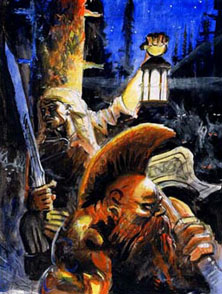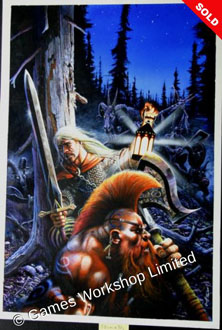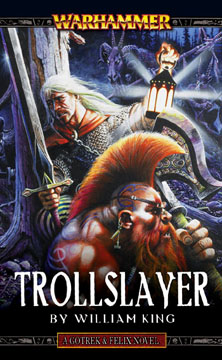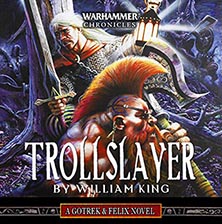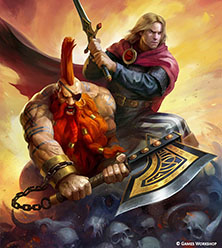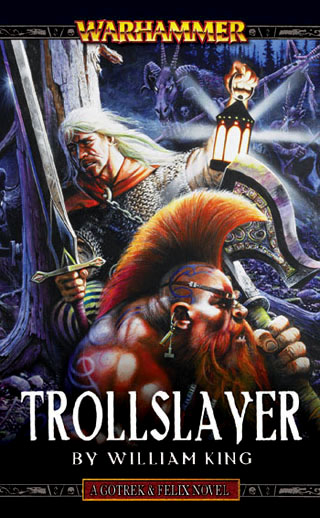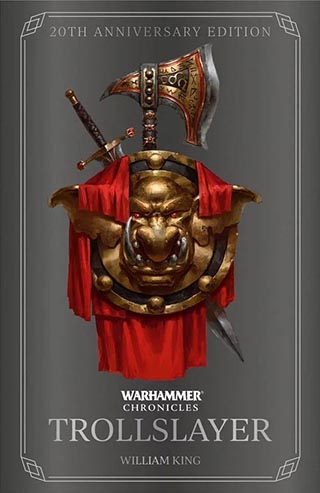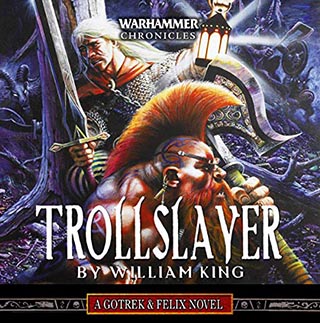Credits
Writer(s)William(Bill) King
MediumPrinted, Novel, Digital, eBook, Audio
PublisherBlack Library
Cover(s)
MediumPrinted, Novel, Digital, eBook, Audio
PublisherBlack Library
Cover(s)
References
- The 1st book of the series!
- The 1st Gotrek & Felix book!
- The 1st Gotrek & Felix Anthology.
- The 1st Gotrek & Felix Anthology Book.
- Written by William(Bill) King.
- The 1st Gotrek & Felix novel by William(Bill) King.
- Cover by John Gravato.
- 1st Gotrek & Felix cover.
- 1st John Gravato cover.
- It consists of the following 7 (stand alone) novellas (with appearing order) :
- First published in the UK by Black Library in August 1999.
- UK ISBN : 1-84154-100-1.
- US edition published by Pocket Books in March 2000.
- US edition : ISBN 0-671-78373-4.
- RePrinted(2nd Printing) in the UK by Black Library in April 2003.
- UK(2nd printing) ISBN : 1-84416-002-5.
- US Edition, RePrinted(2nd Printing) :
- Published by the Black Library in May 2003.
- 2nd Printing(UK and US) Cover Artist : Geoff Taylor.
- A free ebook edition was made available on the Black Library website in October 2010.
- E-Book edition cover by Geoff Taylor.
- RePrinted in the UK by Black Library in October 2013 as Black Library Classics series.
- Also published as an eBook(in the same month).
- Both book and eBook available for a limited time (limited edition).
- Black Library Classic Cover by Nicolas Delort.
- 1st Nicolas Delort cover.
- It has an introduction by William King(see below for further details).
- A Mighty Fact!
- Released, also, as an Audio book by Black Library in November 2019.
- Narrated by : Jonathan Keeble.
- Audio cover artist : Geoff Taylor.
- Running time(duration) : 9 hours 56 minutes.
- RePrinted in the UK by Black Library in 29 November 2019 as Black Library 20th Anniversary Edition.
- Also published as an eBook(in the same month).
- Both book and eBook available for :
- A limited time (limited edition).
- Pre-order started in 23 November 2019.
- A Hard cover only edition.
- Black Library 20th Anniversary Edition cover : Rezunenko Bogdan.
- 1st Rezunenko Bogdan cover.
- It has an introduction by William King(see below for further details).
- Also, the following original paintings(ie., without letters, etc) :
- Geoff Taylor’s 1st Omnibus cover painting.
- Greg Staples’ Goblinslayer cover painting.
- John Gravato’s TrollSlayer cover painting.
- Geoff Taylor’s TrollSlayer cover painting.
- Anna Lakisova
- Anna Lakisova (re-imagined) the iconic John Gravato’s cover painting. This image was published in The Art of Warhammer Age of Sigmar and Warhammer Fantasy Battles with the following note :
- The artist has honoured the original cover of the first Gotrek novel by using the same layout, colours and characterful expressions. However, the image is beautifully rendered using contemporary illustration techiques to bring it in line with more modern artwork.
- A Mighty Fact!
- Notes :
- The 1st ever Black Library novel!
- Cover paintings are included without letters / titles.
- Also, included a visual concept – rough prior to painting the cover by Geoff Taylor.
- This is an anthology book, with loose connected or totally independent novellas. So, each story is a chapter and it features a different adventure with different supporting characters and different villains.
- Novellas from this book and the book itself is included in numerous other (printed and digital) omnibus, collections, bundles, etc. For more details-information check their tags.
- In his introduction from the 2013 edition of Trollslayer(Black Library Classics), William King revealed that :
- He wrote Geheimnisnacht as a one-off story, in 1988, in which Gotrek was meant to die at the end, but later revised it based on his liking for the characters(Gotrek’s fake death in the story was initially written as permanent). In his own words : ” People often ask me how Gotrek Gurnisson dies. I usually give an evasive answer, but the truth is that I have already written his death scene. I did it in the very first version of the very first story of this book, ‘Geheimnisnacht’. If you look closely, you can even see where it happens. There’s a moment where the Slayer (and he was a Slayer a long time before Buffy) goes down beneath a tide of mutants. In the original version of the story, that’s where he dies and Felix has to save himself.”
- ”Reading over my first draft on that long-ago day some time in 1988, I thought wait a minute, what am I doing? These are great characters. They could run and run. It wasn’t purely mercenary considerations that made me think that, although even at the relatively youthful age of 28, I had a sound grasp on the commercial realities – series as well. There was something about this pair. They were more than just echoes of the classic sword and sorcery duos that had influenced me, such as Fafhrud and the Grey Mouser, or Moonglum and Elric. Right from the get-go, Gotrek and Felix were very amusing(to me at least). They were visually distinctive. They lept right off the page.”
- ”In part they are how they are because of where I came from. These days the influence of Warhammer is everywhere: in games, in comics, in novels. To someone of my age, who had grown up with Tolkien and the clones that followed, it was anything but generic. It was a revolution.”
- ”It had sinister apocalyptic cults lurking in the background working away to undermine civilisation. It had fantastic imagery. Gotrek and Felix were citizens of that world. Felix is a representative of the rising mercantile classes. Gotrek is a drunken and savage member of an elder race that’s on the slide. You look over their shoulders and you can see where they came from.”
- ”In part they are how they are because of where I came from. I don’t mean the influence of working class Scottish culture either, although there are definite traces of it in Gotrek’s hard man persona and black humour. It comes from how I got into Warhammer. Unlike the majority of people, I did not get into it from the miniatures side but from the role-playing side. I was an enthusiastic player of Warhammer Fantasy Roleplay from the very start. I chose to write about a dwarf Slayer because they were the most popular role in the game among my players, and it was easy to see why. They were original, distinctive and very appealing in a nihilistic sort of way. The role-playing game featured a very detailed and, to me, very believable society that just begged to be the setting for stories.”
- ”The plot of ‘Geheimnisnacht’ came from a game I ran for friends and family in Edinburgh one summer. It really was that simple. I just put Gotrek and Felix into the same situation as my players had been and watched them run with it. The fun of it was not in the plot but in the way they dealt with it and in the interaction between the pair. There was as much conflict between them and their world views as there was with the sinister followers of Chaos. It was a pattern I was to follow in the next few stories.”
- ”The story was enormously enjoyable to write, and of a type I had always wanted to write – classic sword and sorcery. Gotrek and Felix are very much heroes of that genre: down at heel, wandering adventurers who live by their own code.”
- ”‘Geheimnisnacht’ was popular with the editors and another story was commissioned. For the life of me I cannot remember why I decided to have the pair light out of the Boarder Princes. I suspect it was because it seemed logical to me sice they were wanted by the law. This led to ‘Wolf Riders’ and into another aspect of the series. Gotrek loses an eye in a fight where he pretty much slaughters an entire tribe of goblins. I wanted to do a series where characters really got wounded and did not stroll invincibly through battlefields and emerge only with cosmetic scars. This also incidentally reflected the brutal critical hit tables of the original Warhammer Fantasy RPG.”
- ”The third story, ‘The Dark Beneath The World’, was an invitation to illustrate the scene on the cover of the role-playing game. It was a picture I loved and I was happy to do it. The characters were illustrations of the painted miniatures shown in the game. I lifted their names from the pages of the book, gave them some backstory and sent them on their way. The story was a chance to look at some of Gotrek’s dwarf heritage and to do a classic dungeon crawl. As with ‘Wolf Riders’, I pretty much made the plot up as I went along and stopped when I had reached the required word count. The characters carried the tale, as they always did.”
- ”The next stories represent a change of pace as well as in my technique. I was commissioned to write a book about the pair, novel length. I had never written a novel before and it was a daunting task, so I decided to make things easier by writing three linked novellas which would be longer than anything I had ever written before, but were still not quite novel length. These dealt with our heroes’ eventual return from the Border Princes and their journey to the city of Nuln. The stories were ‘The Mark of Slaanesh’, ‘Blood and Darkness’ and ‘Skaven’s Claw’ (which does not appear in this book but in Skavenslayer [the follow-up novel to Trollslayer – ed.]). You can see some of my growth as a writer. They are shown from different points of view and the plotting is somewhat more complex than random violent encounters strung together until I reached a required word count. The Slaanesh story is notable for Felix being forced to take on the role of hero as Gotrek is turned amnesiac by a blow to the head. ‘Blood and Darkness’, as its title would suggest, was the darkest and nastiest of the stories written and our heroes’ involvement is almost incidental. It is really the tale of Justine, the Chaos Warrior, and her return home in search of Vengence.”
- ”Sadly, GW Books was closed before what would have been my first novel-length work hit the stores and that seemed to be it for Gotrek and Felix. I went on to write other things until late in the 90s I ran into Andy Jones in a bar at a convention in the United States. He told me that Games Workshop were restarting their book line and asked if I would care to do some more Gotrek and Felix stories for the new fiction magazine they were planning, and perhaps a novel or two to go with it. I leapt at the chance, and in due course, ‘The Mutant Master’ and ‘Ulric’s Children’ appeared in Inferno!. The collected stories went into this volume along with the linking matter from Felix’s journal to give the whole tale some coherence.”
- Notes (from Trollslayer Black Library Classics Introduction ) :
- He was 28 years old when he wrote the first story.
- He was influenced from Fafhrud and the Grey Mouser, and Moonglum and Elric. Of course, he has grown up with Tolkien and the clones that followed.
- The plot of ‘Geheimnisnacht’ came from a game he ran for friends and family in Edinburgh one summer. He just put Gotrek and Felix into the same situation as his players had been and watched them run with it. The fun of it was not in the plot but in the way they dealt with it and in the interaction between the pair. There was as much conflict between them and their world views as there was with the sinister followers of Chaos. It was a pattern he follow in the next few stories.
- Trollslayer, a novel written by William King, is the first in a series of many books following the adventures of Gotrek & Felix. The book is an anthology. Some of these chapters are old stories of William King written(and published) in the late 80s and early 90s. These stories were gathered together and new ones were added to create Trollslayer, a compilation of seven short stories. Only The Mark of Slaanesh and Blood and Darkness were previously unreleased stories.
- The story led to the commissioning of another by Games Workshop, and then another, which led to Wolf Riders and The Dark Beneath the World.
The success of these three stories led to King being commissioned to write a full-length novel, which he approached by writing three novella-length stories in episodic format, which became The Mark of Slaanesh, Blood and Darkness, and Skaven’s Claw. - However, Games Workshop Books closed unexpectedly, and the publication of the novel was delayed until 1999, when it also included The Mutant Master and Ulric’s Children, which had previously been published in Inferno! magazine. The novel also added the prefacing excerpts from Felix’s journal.
- The Mark of Slaanesh and Blood and Darkness were eventually published as part of Trollslayer, while Skaven’s Claw became the first chapter of the subsequent novel Skavenslayer.
- In his introduction from the 2019 edition of Trollslayer(20th Anniversary Edition), William King revealed that :
- It is more that 30 years since he first wrote for Gotrek & Felix.
- ”The original stories were commissioned by David Pringle, the editor of GW Books, the precursor to Black Library. Back then David was also the editor of Interzone, the SF magazine to which I had just made my first sale. When I saw he had got the job at GW Books, I wrote to him saying, ‘I play these games, I know the background, I could write this stuff.’ David replied that he was putting together an anthology of short stories. Why didn’t I try writing 7,000 words for it? I resolved to give it my best shot.”
- ”I was a big Warhammer Fantasy Roleplay gamer back in those days. Dwarf Slayers were among the most popular character types with my players. People loved the concept. I mean, what’s not to love about suicidal punk dwarfs with big axes? That’s where Gotrek came from. I lifted the name from an alcoholic dwarf called Gottri Gurnisson in the scenario book Shadows over Bogenhafen. I changed a syllable, modified the personality to that of a dour Scottish hard man, and I was up and running. I even had a story ready. ‘Geheimnisnacht’ was based on a scenario I had run for family and friends in Edinburgh. Since I planned on Gotrek meeting a suitable doom at the end of the story, I needed another character to live and tell the tale. That was Felix’s job. The oath-swearing arrangement formalised it inside the narrative.”
- Note : this paragraph is similar to William King’s interview from White Dwarf : November 2018 issue.
- ‘In my first version of the story, Gotrek died slaughtering the cultists. By that point though I was thinking, what am I doing? I can get a whole series of stories out of this pair. So the ending got rewritten, Gotrek survived, and the rest is history.‘
- ‘A few more stories were written for the GW Books anthologies – ‘Wolf Riders’ was the title story of one of the collections. ‘The Dark Beneath the World’ was written so that the original cover illustration from Warhammer Fantasy Roleplay (1986 edition) could be used as a cover for that anthology. That idea fell through but it does explain why the supporting characters in the story have the same names as some of the miniatures in that old rulebook – the ones for the characters on the covers.‘
- ‘Before GW Books ceased publishing new titles I was asked for a book of stories about Gotrek and Felix. I wrote three of them – ‘The Mark of Slaanesh’, ‘Blood and Darkness’ and ‘Skaven’s Claw’ – (which later became the core of the novel Skavenslayer). The book never came out, much to my disappointment, and I thought that was the end of the road for the redoubtable pair.‘
- ‘Fast forward about seven years to 1998 (I think), and Andy Jones approached me at a convention in the US with the news that GW was returning to the fiction business and would be producing a new magazine, Inferno. That’s where ‘The Mutant Master’ and ‘Ulric’s Children’ come from.‘
